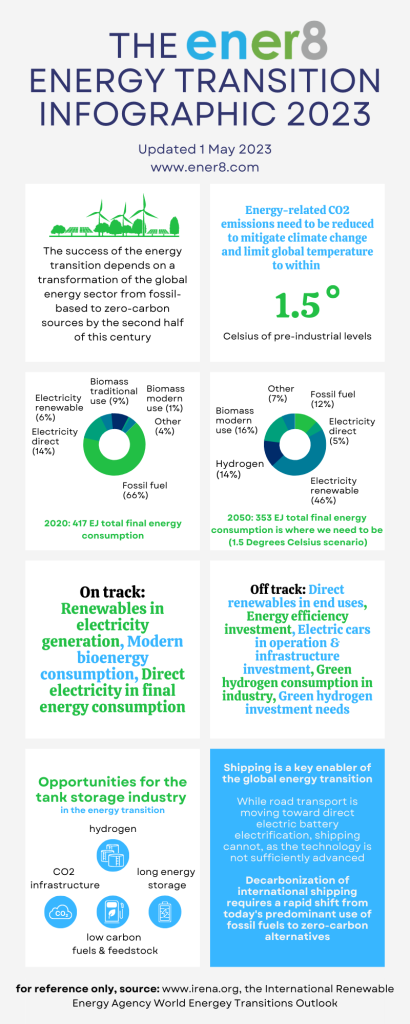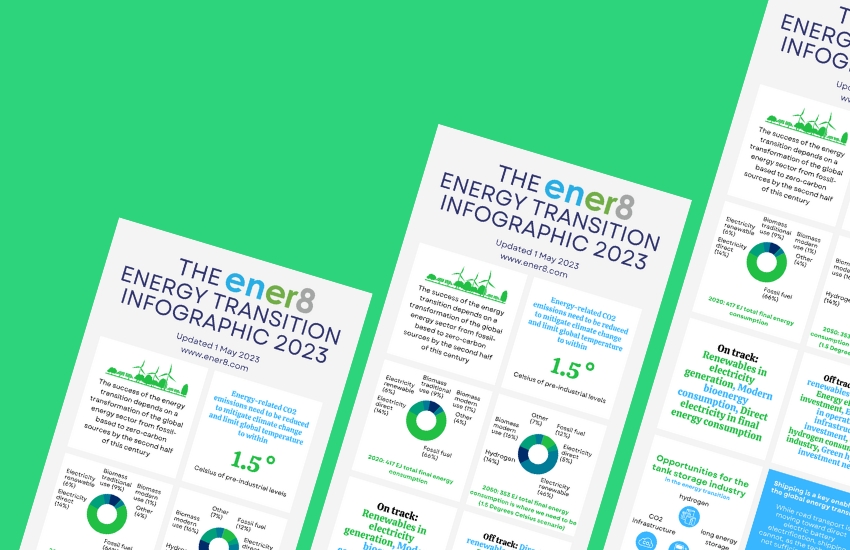Energy Transition Infographic: 2023 Update
Our Energy Transition Infographic 2023 Update gives you a visual representation of crucial data shaping the energy transition. As we help companies in the liquid bulk and chemical supply chain, we like focusing on this trend toward sustainability.

Energy Transition Infographic review
The energy transition refers to the shift of the energy sector from fossil-based sources of energy production and consumption, such as oil, and coal, to renewable energy sources, such as wind and solar. The success of the energy transition relies on a transformation of the global energy sector from fossil-based to zero-carbon sources by the second half of this century.
We sourced the data in our Infographic from the International Renewable Energy Agency (IRENA) World Energy Transition Outlook. IRENA is a lead global intergovernmental agency for energy transformation that serves as the principal platform for international cooperation, supports countries in their energy transitions, and provides state-of-the-art data and analyses on technology, innovation, policy, finance, and investment.
Energy-related CO2 emissions need to be reduced to mitigate climate change and limit global temperature to within 1.5° Celsius of pre-industrial levels. The 1.5° Celsius Scenario predicts that electricity will become the main energy carrier with a share of 50% of total final energy consumption. Renewable energy, energy efficiency, and the electrification of end-use sectors will contribute to this repositioning. Modern biomass (16%) and hydrogen (14%) are predicted to take up a more notable role in the energy mix. 94% of hydrogen consumption is forecasted to be derived from renewables. That also points to a decrease in overall energy consumption from 470 EJ (exajoule) in 2020 to 353 EJ in 2050. This decrease of 15% is important for a sustainable future and is where we need to be. Note that the data in our Infographic only includes energy consumption, excluding non-energy uses.
It is also important to track progress. According to IRENA, we are on track for renewables in electricity generation, modern bioenergy consumption, and direct electricity in final energy consumption. However, we are running behind on direct renewables in end uses, energy efficiency investment, electric cars in operation & infrastructure investment, green hydrogen consumption in industry, and green hydrogen investment needs. Making progress on these and other key energy system components is crucial to achieving the 1.5°C scenario.
The tank terminal industry plays an important role in the energy transition. There are many opportunities for the sector as there is a need for investment in energy storage infrastructure. These opportunities include hydrogen storage, CO2 infrastructure, low-carbon fuel & feedstock storage, and long-energy storage. Storage of hydrogen covers liquid organic hydrogen carriers, ammonia, and liquid hydrogen. CO2 infrastructure is needed for liquid carbon dioxide storage. Low-carbon feedstock storage focuses on recycled feedstocks, biofuels, methanol, and ammonia. Long energy storage covers the storage of clean electricity.
Shipping is another key enabler of the global energy transition. While road transport is moving toward direct electric battery electrification, shipping cannot, as the technology is not sufficiently advanced. Decarbonization of international shipping, therefore, requires a rapid shift from today’s predominant use of fossil fuels to zero-carbon alternatives.
Useful blog posts
You may also be interested in blog post 1 – 4 Actions To Bolster Your Liquid Bulk Supply Chain Performance, blog post 2 – 3 Sustainable Development Goals Businesses Should Have, and blog post 3 – Energy Transition: What Is The Impact On Big Oil.
Recommended Infographics
Chemical Market Facts & Figures Infographic: 2023 Update
Energy Outlook Infographic: 2023 Update
Merchant Fleet Infographic: 2023 Update
Tank Container Infographic: 2023 Update
Tank Terminal Infographic: 2023 Update
Photo Credit: ener8

